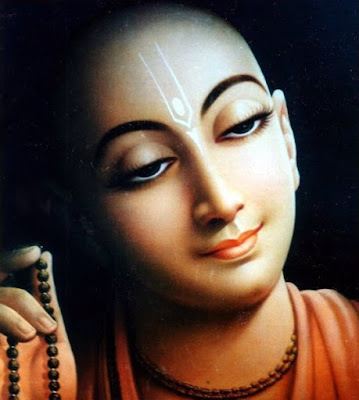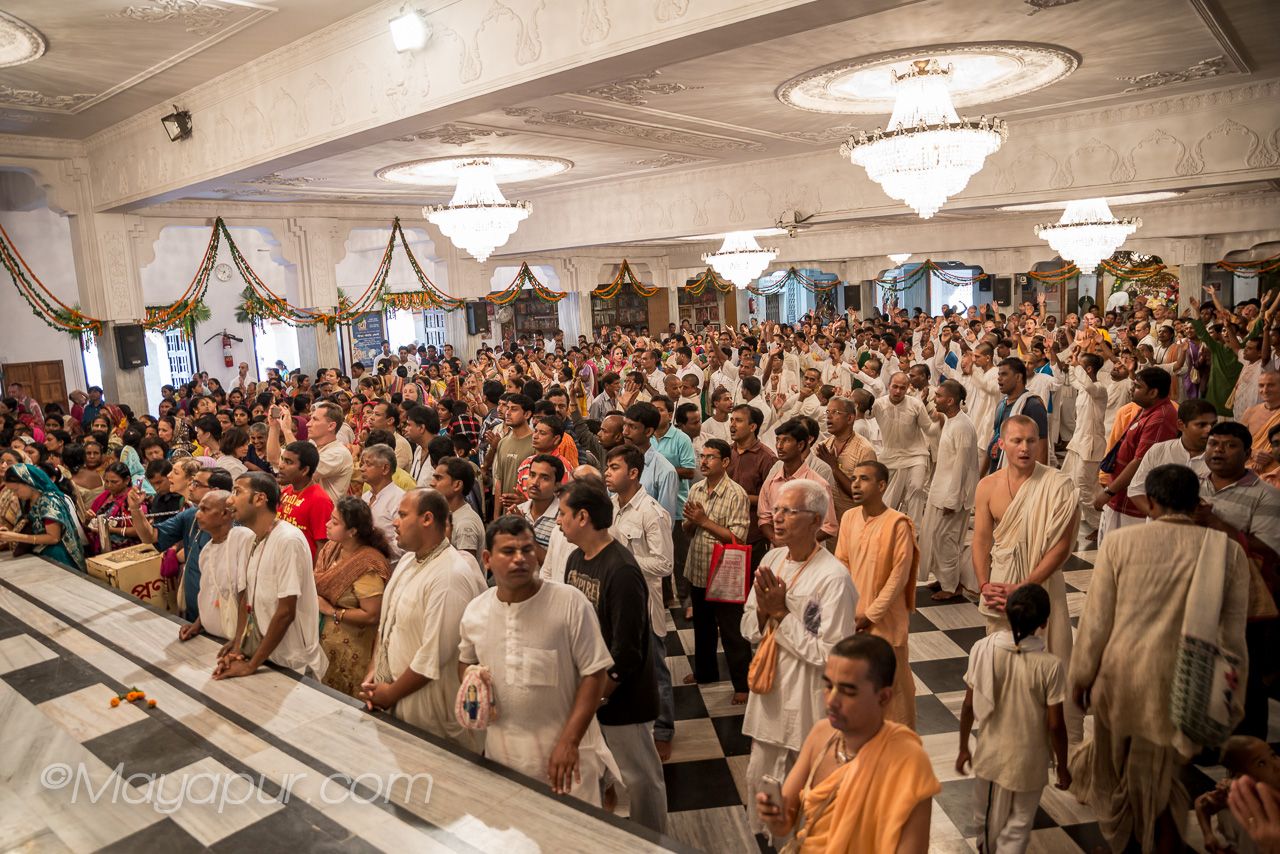BY SHANTHI RUPA DEVI DASI
KUALA LUMPUR - Below is the excerpts from the transcription of a lecture given by on September 18, 1969 in London, on the occasion of the appearance anniversary of Srimati Radharani
Rādhārāṇī…, today is Rādhārāṇī’s appearance day. So we should try to understand Rādhārāṇī’s feature. Rādhārāṇī is the pleasure potency, hlādinī-śakti. Ānandamayo ’bhyāsāt. In the Vedānta-sūtra the Absolute Truth is described asānandamaya, always in pleasure potency. That ānandamaya potency… Just like ānanda. When you want ānanda, pleasure, you cannot have it alone. Alone, you cannot enjoy. When you are in the circles of friend or family or other associates, you feel pleasure. Just like I am speaking. The speaking is very pleasing when there are many persons here. I cannot speak alone here. That is not ānanda. I can speak here at night, dead of night, nobody here. That is notānanda. Ānanda means there must be others. So because Kṛṣṇa, the Absolute Truth, is ānandamaya, therefore eko bahu syām, He has become many. We are also Kṛṣṇa’s part and parcel, to give pleasure to Kṛṣṇa. And the chief pleasure potency is Rādhārāṇī.
rādhā-kṛṣṇa-praṇaya-vikṛtir hlādinī-śaktir asmād ekātmānāv api bhuvo (purā) deha-bhedo-gatau tau caitanyākhyaṁ prakaṭam adhunā tad-dvayaṁ caikyam āptaṁ rādhā-bhāva-(dyuti)-suvalitaṁ naumi kṛṣṇa-svarūpam (Cc. Adi 1.5)
So Kṛṣṇa is Param Brahman, as you know from the Bhagavad-gītā. When Arjuna understood Bhagavad-gītā, he affirmed Kṛṣṇa, paraṁ brahma paraṁ dhāma pavitraṁ paramaṁ bhavān (Bg. 10.12) So Kṛṣṇa is Param Brahman. So in this material world we see that a great, saintly person, simply to enjoy brahmānanda, he gives up everything of material enjoyment. He becomes sannyāsī. Ahaṁ brahmāsmi. Just to understand that he is in Brahman realization. So if one has to give up everything material for Brahman realization, do you think that Paraṁ Brahman, the Supreme Brahman, can enjoy anything material? No. Kṛṣṇa’s enjoyment is nothing material. This point should be understood. For Brahman realization we are giving up everything material. And how Paraṁ Brahman can enjoy anything material? This question has been very much nicely discussed by Jīva Gosvāmī.
So when the Param Brahman… First of all, the Param Brahman information is not there in this material world. Little Brahman information is there. Or little Paramātmā information is there. But not Param Brahman, or Bhagavān, information. Therefore it is said, manuṣyāṇāṁ sahasreṣu kaścid yatati siddhaye (Bg. 7.3). Siddhaye means to understand Brahman or Paramātmā. But out of many such persons who have realized Brahman and Paramātmā, hardly a person can know Kṛṣṇa. And that… First of all… [break] …what we can understand about Kṛṣṇa’s pleasure potency? If I want to know some big man. That is one process. And without knowing that big man, how I can understand about his internal affairs? Similarly, if we do not understand Kṛṣṇa, how we can understand how Kṛṣṇa is enjoying? That is not possible. But the Gosvāmīs, they’re giving us information what is the pleasure potency of Kṛṣṇa. That is Śrīmatī Rādhārāṇī.
So we have described about the Rādhā-Kṛṣṇa loving affairs in our Teachings of Lord Caitanya in page 264. If you have got this book, you can read it, how the reciprocation of loving affairs of Rādhā- Kṛṣṇa is there, transcendental. So our today prayer to Rādhārāṇī… We pray to Rādhārāṇī because She is the pleasure potency of Kṛṣṇa. Kṛṣṇa means “all-attractive.” But Rādhārāṇī is so great that She attracts Kṛṣṇa. Kṛṣṇa is all-attractive, and She is attractive (attractor) of Kṛṣṇa. So what is the position of Śrīmatī Rādhārāṇī? We should try to understand this day and offer our obeisances to Rādhārāṇī. Rādhe vṛndāvaneśvarī.
tapta-kāñcana-gauraṅgī rādhe vṛndāvaneśvarī vṛṣabhānu-sute devī pranamāmi hari-priye
Our business is “Rādhārāṇī, You are so dear to Kṛṣṇa. So we offer our respectful obeisances unto You.”
tapta-kāñcana-gauraṅgī rādhe vṛndāvaneśvarī vṛṣabhānu-sute devī pranamāmi hari-priye
Rādhārāṇī is hari-priyā, very dear to Kṛṣṇa. So if we approach Kṛṣṇa through Rādhārāṇī, through the mercy of Rādhārāṇī, then it becomes very easy. If Rādhārāṇī recommends that “This devotee is very nice,” then Kṛṣṇa immediately accepts, however fool I may be. Because it is recommended by Rādhārāṇī, Kṛṣṇa accepts. Therefore in Vṛndāvana you’ll find all the devotees, they’re chanting more Rādhārāṇī’s name than Kṛṣṇa’s. Wherever you’ll go, you’ll find the devotees are addressing, “Jaya Rādhe.” You’ll find still in Vṛndāvana. They are glorifying Rādhārāṇī. They’re more interested, worshiping Rādhārāṇī. Because however fallen I may be, if some way or other I can please Rādhārāṇī, then it is very easy for me to understand Kṛṣṇa. Otherwise,
manuṣyāṇāṁ sahasreṣu kaścid yatati siddhaye yatatām api siddhānāṁ kaścid vetti māṁ tattvataḥ (Bg. 7.3)
If you go by the speculative process to understand Kṛṣṇa, it will take many, many lives. But if you take devotional service, just try to please Rādhārāṇī, and Kṛṣṇa will be gotten very easily. Because Rādhārāṇī can deliver Kṛṣṇa. She is so great devotee, the emblem of mahā-bhāgavata. Even Kṛṣṇa cannot understand what is Rādhārāṇī’s quality. Even Kṛṣṇa, although He says vedāhaṁ samatītāni, “I know everything,” still, He fails to understand Rādhārāṇī. Rādhārāṇī is so great. He says that… Actually, Kṛṣṇa knows everything. In order to understand Rādhārāṇī, Kṛṣṇa accepted the position of Rādhārāṇī. Kṛṣṇa wanted to understand the potency of Rādhārāṇī. Kṛṣṇa thought that “I am full. I am complete in every respect, but still, I want to understand Rādhārāṇī. Why?” This propensity made Kṛṣṇa obliged to accept the propensities of Rādhārāṇī, to understand Kṛṣṇa, Himself.
These are, of course, very transcendental, great science. One who is advanced in Kṛṣṇa consciousness and well conversant with the śāstras, they can understand. But still, we can discuss from the śāstra. When Kṛṣṇa wanted to understand Himself, He took the tendency of Śrīmatī Rādhārāṇī. And that is Caitanya Mahāprabhu. Rādhā-bhāva-dyuti-suvalitam. Caitanya Mahāprabhu is Kṛṣṇa, but He has accepted the propensities of Rādhārāṇī. As Rādhārāṇī is always in feelings of separation of Kṛṣṇa, similarly, in the position of Rādhārāṇī, Lord Caitanya was feeling separation of Kṛṣṇa. That is the teachings of Lord Caitanya, feelings of separation, not meeting. The process of devotional service taught by Caitanya Mahāprabhu and His disciplic succession is how to feel separation from Kṛṣṇa. That is Rādhārāṇī’s position, always feeling the separation.
The Gosvāmīs, they also, when they were in Vṛndāvana, they never said that “I have seen Kṛṣṇa.” Although they were the most perfect, they never said that “I have seen Kṛṣṇa.” Their prayers were like this: he rādhe! vraja-devīke! he nanda-suno! kutaḥ. He rādhe, Rādhārāṇī, he rādhe! vraja-devīke! ca. Rādhārāṇī does not remain alone. He (She) remains always with His (Her) friends, vraja-devī, Lalitā or Viśākha and other damsels of Vṛndāvana. So the Gosvāmīns are praying, in their mature stage, when they were living at Vṛndāvana, they were praying in this way, he rādhe! vraja-devīke! ca lalite! he nanda- suno! kutaḥ: “Where, Rādhārāṇī, where You are? Where are Your associates? Where You are, Nanda-suno, the son of Nanda Mahārāja, Kṛṣṇa? Where you are, all?” They were searching after. They never said, “I have seen Kṛṣṇa dancing with the gopīs. Last night I saw.” (laughter) This is sahajiyā. This is not mature devotee. This is called… They are called sahajiyā. They take everything very cheap—Kṛṣṇa very cheap, Rādhārāṇī very cheap—as if they can see every night. No. The Gosvāmīs do not teach us like that. They’re searching after. He rādhe! vraja-devīke! ca lalite! he nanda-suno! kutaḥ, śrī-govardhana-pādapa-tale kālindī-vanye kutaḥ: “Are you there under the Govardhana Hill or on the banks of the Yamunā?” Kālindī-vanye kutaḥ. Ghoṣantāv iti sarvato vraja-pure khedair mahā-vihvalau. Their business was crying like this, “Where You are? Where You are, Rādhārāṇī? Where you are, Lalitā, Viśākha, the associates of Rādhārāṇī? Where You are, Kṛṣṇa? Are You near Govardhana Hill or on the bank of the Yamunā?” Ghoṣantāv iti sarvato vraja-pure. So throughout the whole tract of Vṛndāvana they were crying and searching after Them, khedair mahā-vihvalau, as if madman. Khedair mahā-vihvalau. Vande rūpa-sanātanau raghu- yugau śrī-jīva-gopālakau.
So we have to follow the footprints of the Gosvāmīs, how to search out Kṛṣṇa and Rādhārāṇī, Vṛndāvana, or within your heart. That is the process of Caitanya Mahāprabhu’s bhajana: feeling of separation, vipralambha, vipralambha-sevā. Just like Caitanya Mahāprabhu, feeling the separation of Kṛṣṇa, He was falling down on the sea. He was coming out of His rest room or His bedroom and going out at dead of night. Nobody knew where He has gone. So that was His searching. This process of devotional service is taught by Caitanya Mahāprabhu. Not that very easily, “We have seen Kṛṣṇa or seen Rādhārāṇī in rāsa-līlā.” No, not like that. Feel the separation. The more you feel separation from Kṛṣṇa, you should understand that you are advancing. Don’t try to see Kṛṣṇa artificially. Be advanced in separation feeling, and then it will be perfect. That is the teachings of Lord Caitanya. Because with our material eyes we cannot see Kṛṣṇa.Ataḥ śrī-kṛṣṇa- nāmādi na bhaved grāhyam indriyaiḥ [BRS. 1.2.234] With our material senses we cannot see Kṛṣṇa, we cannot hear about Kṛṣṇa’s name. But sevonmukhe hi jihvādau. When you engage yourself in the service of the Lord… Where the service begins? Jihvādau. The service begins from the tongue. Not from the legs, eyes, or ears. It begins from the tongue. Sevonmukhe hi jihvādau. If you begin service through your tongue… How? Chant Hare Kṛṣṇa. Use your tongue. Hare Kṛṣṇa, Hare Kṛṣṇa, Kṛṣṇa Kṛṣṇa, Hare Hare/ Hare Rāma, Hare Rāma, Rāma Rāma, Hare Hare. And take Kṛṣṇa prasādam. The tongue has got two business: to articulate sound, Hare Kṛṣṇa; and take prasādam. By this process you’ll realize Kṛṣṇa.
Devotee: Haribol!
Prabhupāda: Don’t try to see Kṛṣṇa. You cannot see Kṛṣṇa with your material eyes. Neither you can hear about Him with your material ears. Neither you can touch. But if you engage your tongue in the service of the Lord, then He’ll reveal Himself to you: “Here I am.” That is wanted. So feel separation of Kṛṣṇa just like Rādhārāṇī, as Lord Caitanya teaches us, and engage your tongue in the service of the Lord; then, one day, when you are mature, you’ll see Kṛṣṇa eye to eye.
Thank you very much.
Devotees: Haribol! All glories to His Divine Grace! (offer obeisances)



 New Vrindaban engaged some students and professors on the West Virgina University (Morgantown, WV) community design team for different projects during the master planning in 2012, one of which was this branding survey. Some pleasantly surprising results came out of their project.
New Vrindaban engaged some students and professors on the West Virgina University (Morgantown, WV) community design team for different projects during the master planning in 2012, one of which was this branding survey. Some pleasantly surprising results came out of their project. 






 Garuda das: This absolutely beautiful large solid gold statue of the cosmic Vishnu was discovered in a temple in South India. Its sheer weight in gold is worth over a billion dollars, and furthermore, it is one of the most exquisite works of sculpture in the history of Indian art. Note the deity of creation, Brahmā, rising out of the navel of Vishnu on the blossom of a lotus flower!
Garuda das: This absolutely beautiful large solid gold statue of the cosmic Vishnu was discovered in a temple in South India. Its sheer weight in gold is worth over a billion dollars, and furthermore, it is one of the most exquisite works of sculpture in the history of Indian art. Note the deity of creation, Brahmā, rising out of the navel of Vishnu on the blossom of a lotus flower!  60 High Resolution photos from beautiful Mayapur: Morning Samskaras
60 High Resolution photos from beautiful Mayapur: Morning Samskaras  7 min vid: Iskcon Brisbane Janmastami 2013 by Vraja Dhama Das
7 min vid: Iskcon Brisbane Janmastami 2013 by Vraja Dhama Das  350 photos: Festival Nama-hatta 29.08.-1.09.2013 at New Santipur - Czarnów near Stone Mountain
350 photos: Festival Nama-hatta 29.08.-1.09.2013 at New Santipur - Czarnów near Stone Mountain